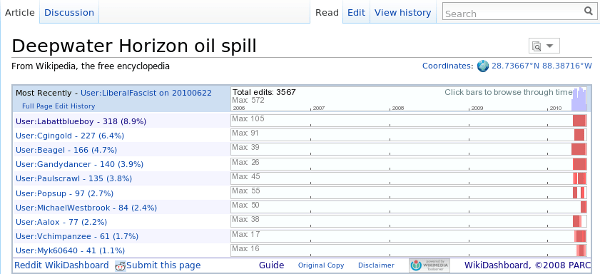Ed Chi, Principal Scientist, Area Manager of Augmented Social Cognition(ASC) at Palo Alto Research Center is a prominent pioneer in social computing and a prolific researcher in the underlying mechanisms in online social systems such as Wikipedia and social tagging sites. Ed gave the keynote talk on Modeling Social Media at the Hypertext 2010 conference a few days ago.
Last October, I had the privilege to share the panel with Ed at BayCHI, where he presented the findings from his joint research, “The Singularity is Not Near: Slowing Growth of Wikipedia”. In addition to the discussion about the possible reasons behind the slow growth, Ed described Wikipedia as “knowledge-ware”, “people-ware” and “tool-ware” in his presentation. This prompted me to reflect on the focus beyond the Wikipedia Usability Initiative. The objective of the Wikipedia Usability Initiative supported by Stanton Foundation was to improve the usability of the editing tools for novice editors.
I had been struggling with competing priorities. Often times investing in future opportunities was postponed due to immediate problems. When the Stanton Wikipedia Usability Initiative approached its project end, I visited Ed with Erik Zachte and Howie Fung to discuss the next user experience endeavor of how to make Wikipedia a more social place. Ed shared his wisdom and suggested to focus on optimizing resources rather than focusing on growth. Growth cannot be expected when resources are not optimized. We also need to know how resources are allocated before optimizing them.
WikiDashboard was developed by the ASC team almost three years ago. It is a great tool to provide dynamic visualization of Wikipedia editing activities. For example, you can see the editing activity of the relatively new article about the Deepwater Horizon oil spill in the Gulf of Mexico, by editor and number of edits over time, at a glance. You can also find out about edit activities by a certain editor by clicking the editors’ user name. Wikidashboard’s social transparency helps readers to see who is writing what, and editors can discover the most active contributors visually before diving into the details listed in the history page.

Facebook implemented Community Pages, a concept of using articles as catalysts to connect people. Community Pages embed Wikipedia articles from the publicly available MediaWiki API into Facebook to connect people to their interests, and they create links inside the user’s profile. Facebook users can discover people with common interests whether they are in their friends network or not.
Wikimedia projects draw over 375 million unique visitors and roughly 100,000 editors edit articles more than five times monthly. Detailed monthly reports can be found here. This huge gap indicates that we are not succeeding in converting visitors to editors. It requires certain skills to write an encyclopedia article, so connecting people over the same interests can be a first step to introduce new contributors into the existing Wikimedia editor community.
Wikimedia projects are about collecting knowledge to share with everyone on the planet. Connecting people with similar interests can help enrich both the reading and the editing experience of this process.
Naoko Komura, Head of User Experience Programs

Can you help us translate this article?
In order for this article to reach as many people as possible we would like your help. Can you translate this article to get the message out?
Start translation